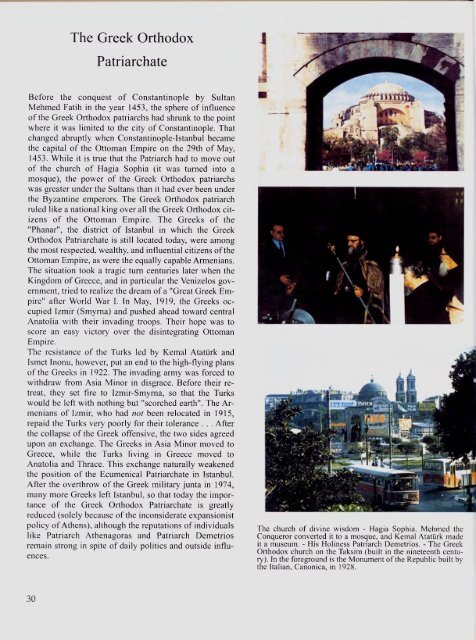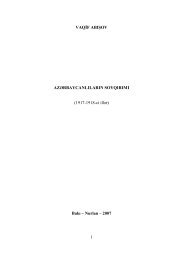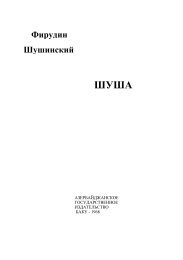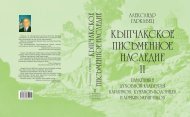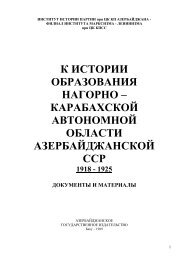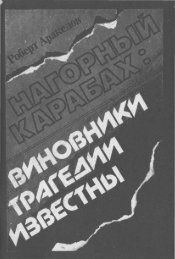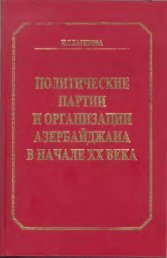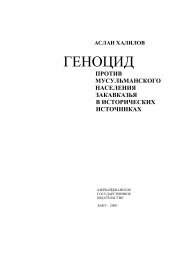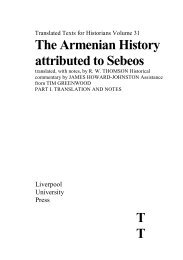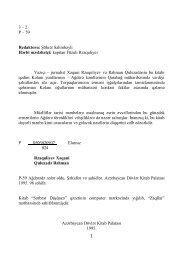ARMENIAN - Erevangala500
ARMENIAN - Erevangala500
ARMENIAN - Erevangala500
Create successful ePaper yourself
Turn your PDF publications into a flip-book with our unique Google optimized e-Paper software.
The Greek Orthodox<br />
Patriarchate<br />
Before the conquest o f Constantinople by Sultan<br />
Mehmed Fatih in the year 1453, the sphere of influence<br />
of the Greek Orthodox patriarchs had shrunk to the point<br />
where it was limited to the city o f Constantinople. That<br />
changed abruptly when Constantinople-Istanbul became<br />
the capital o f the Ottoman Empire on the 29th of May,<br />
1453. While it is true that the Patriarch had to move out<br />
of the church o f Hagia Sophia (it was turned into a<br />
mosque), the power of the Greek Orthodox patriarchs<br />
was greater under the Sultans than it had ever been under<br />
the Byzantine emperors. The Greek Orthodox patriarch<br />
ruled like a national king over all the Greek Orthodox citizens<br />
o f the Ottoman Empire. The Greeks o f the<br />
"Phanar", the district of Istanbul in which the Greek<br />
Orthodox Patriarchate is still located today, were among<br />
the most respected, wealthy, and influential citizens of the<br />
Ottoman Empire, as were the equally capable Armenians.<br />
The situation took a tragic turn centuries later when the<br />
Kingdom of Greece, and in particular the Venizelos government,<br />
tried to realize the dream of a "Great Greek Empire"<br />
after World War I. In May, 1919, the Greeks occupied<br />
Izmir (Smyrna) and pushed ahead toward central<br />
Anatolia with their invading troops. Their hope was to<br />
score an easy victory over the disintegrating Ottoman<br />
Empire.<br />
The resistance of the Turks led by Kemal Atatiirk and<br />
Ismet Inonu, however, put an end to the high-flying plans<br />
o f the Greeks in 1922. The invading army was forced to<br />
withdraw from Asia Minor in disgrace. Before their retreat,<br />
they set fire to Izmir-Smyma, so that the Turks<br />
would be left with nothing but "scorched earth". The Armenians<br />
o f Izmir, who had not been relocated in 1915,<br />
repaid the Turks very poorly for their tolerance . . . After<br />
the collapse o f the Greek offensive, the two sides agreed<br />
upon an exchange. The Greeks in Asia Minor moved to<br />
Greece, while the Turks living in Greece moved to<br />
Anatolia and Thrace. This exchange naturally weakened<br />
the position of the Ecumenical Patriarchate in Istanbul.<br />
After the overthrow of the Greek military junta in 1974,<br />
many more Greeks left Istanbul, so that today the importance<br />
o f the Greek Orthodox Patriarchate is greatly<br />
reduced (solely because of the inconsiderate expansionist<br />
policy of Athens), although the reputations of individuals<br />
like Patriarch Athenagoras and Patriarch Demetrios<br />
remain strong in spite o f daily politics and outside influences.<br />
30<br />
The church of divine wisdom - Hagia Sophia. Mehmed the<br />
Conqueror converted it to a mosque, and Kemal Atatiirk made<br />
it a museum. - His Holiness Patriarch Demetrios. - The Greek<br />
Orthodox church on the Taksim (built in the nineteenth century).<br />
In the foreground is the Monument o f the Republic built by<br />
the Italian, Canonica, in 1928.


